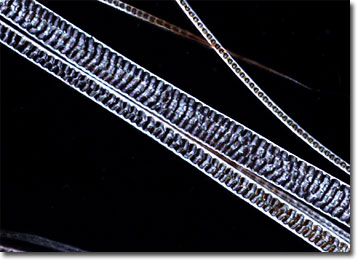Polarized Light Microscopy Digital Image Gallery
Mouse Hair
The word mouse has no precise scientific definition, but is rather utilized as a general term to refer to a wide variety of small rat-like rodents. Many of the most familiar mouse species, however, such as the common house mouse, are members of the family Muridae.

View a second image of Mouse Hair
Mice can be found in almost every type of habitat around the world, with the exception of Antarctica. In several locales, however, the animals are not native, but were rather introduced by humans. Generally nocturnal in nature, mice are primarily terrestrial creatures, although many are good climbers and swimmers. Diet varies somewhat by species, but most consume, seeds, insects, vegetation, and just about anything else they come across that is digestible. Prolific breeders, many mice reproduce throughout the year, although it is a seasonal occurrence in some species.
Despite the fact that they are often considered pests, mice have been utilized by humans in various ways throughout history. They have, for instance, served as food in some areas, as well as a source of fur. Also, in recent years, the active, playful animals have become fairly common as pets. Nevertheless, the single greatest use of mice occurs in the laboratory. Laboratory mice are special breeds of house mice, which are utilized in many scientific experiments because of their close mammalian relationship to humans. They are further well suited for such studies because they are easy to handle, inexpensive to house, and breed quickly. Information gained from work with laboratory mice has been invaluable to the modern understanding of anatomy, physiology, genetics, and behavioral science.
